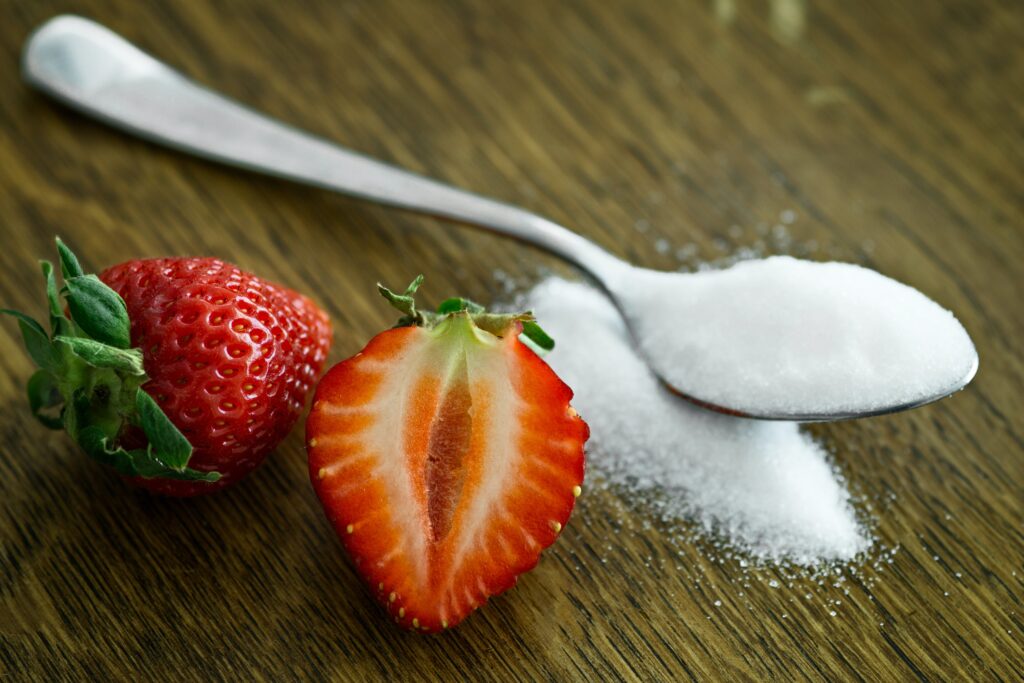My Bittersweet Relationship with Sugar
Sugar and I go way back. I’ve been addicted to the sweet stuff my whole life, without even being aware of it. As a kid, I’d get sugar highs from desserts at my grandma’s house. She’d spoil me rotten with tasty croissants and churros – we were two peas in a pod when it came to our sweet teeth!
My sugary habits continued into my teens, resulting in constant breakouts. I caked on makeup in my 20s to hide my pimply face, which I now regret. In university, I relied on sugary lattes to wake me up, only to crash hard later. My PhD days were fueled by morning milk-and-sugar coffees.

I lived for that caffeine and sugar rush, but then I’d feel depleted, needing calming teas to ease my frayed nerves. What a vicious cycle!
When lockdown hit, my daily latte ritual got disrupted. Around the same time, my partner Maciek was connecting the dots on sugar’s ill effects. We both decided to kick the sugar habit. Eventually, I switched to tasty matcha green tea instead – an excellent choice!
That’s when we discovered how sneaky and harmful sugar can be. Here’s what we learned about why it may be the most insidious food of all…
The Bittersweet Truth: Sugar’s Health Effects Under the Microscope
Sugar is a tricky ingredient. It makes food taste heavenly and helps preserve freshness, so it’s no wonder sugar is added to everything! But like a charming friend who leads you astray, sugar can negatively impact our health when consumed in excess. Let’s explore the latest science behind sugar’s bittersweet effects.
Why We Crave Sugar
Remember that study where rats got addicted to sugar more than cocaine? We humans aren’t much different. While a little sugar in moderation is fine, too much can wreak havoc on our health, fueling obesity, diabetes, and more.
Sugar also increases appetite, so our demand for sugary foods rises, especially when we go grocery shopping hungry! Be sure to eat before shopping to make better choices and resist sugar’s siren call.
Sugar and Cancer
According to Dr. Buttar, excess carbs supply more fuel than our bodies can utilize. When our bodies struggle to handle high sugar levels, the surplus is stored as fat. Interestingly, cancer cells also thrive on this abundant glucose. It’s as if cancer takes advantage of the extra sugar in our bloodstream to throw a lively party! Studies affirm sugar’s role in fueling cancer, with some cancers, like lymphomas, being more susceptible to glucose restriction. Others, such as solid tumors of the breast or pancreas, can use alternative fuels like glutamine and fatty acids. This implies that a complete glucose restriction may not be sufficient to ‘crash the party,’ but it will certainly dampen the vibes.
In a 2012 study examining glucose deprivation in human colon and breast cancer cell lines, while complete glucose removal inhibited proliferation and killed some cells, cancer cells survived by switching to alternative fuels like glutamine and fatty acids. This metabolic flexibility allowed them to persist despite hypoglycemia (medical condition characterized by abnormally low levels of blood glucose), especially in colon cancer cells. Researchers found that the ability to survive glucose limitation was associated with more aggressive, treatment-resistant tumors.
In a 2011 study, researchers noted that reducing carbs may slow cancer growth. Most cancer cells heavily rely on glucose (sugar) for fuel, unlike normal cells. The study also explains that high levels of insulin and insulin-like growth factors, increased by carb-heavy (CHO-heavy) diets, can directly promote tumor growth. This concept is also mentioned in Dr. Veronique’s book.
But what exactly are insulin and insulin-like growth factors? I’ll delve deeper into what insulin is in the ‘Sugar and Your Pancreas’ section, but in short, it’s a hormone produced by the pancreas that enables cells to convert glucose into energy. Insulin-like growth factors are proteins triggered by the insulin hormone that promote cell growth and multiplication. Don’t worry; this is all you need to understand the core of this section.
Returning to our discussion, on the other side of the coin, ketone bodies produced with low insulin and blood glucose levels, such as during intermittent fasting, can inhibit cancer cell growth. Low-carbohydrate ketogenic diets have shown promise in animal models, as seen in a study published in Nature Communications in 2022. Many cancer patients exhibit altered glucose metabolism, making them potential candidates for diets with higher protein and fat intake. This connection emphasizes the impact of dietary choices on cancer risk and treatment possibilities. However, more research is still needed to fully comprehend the intricate relationship between diet, metabolic factors like insulin, and cancer.
Refined Carbs and Fake Sweets
The worst carbs are simple because they assimilate quickly, spiking blood sugar. Dr. Buttar recommends eating protein first to slow carb absorption and prevent the sugar rollercoaster ride. It’s best to avoid refined sugar, syrups, white flour products, and limit fruits to green, low-sugar varieties according to Dr. Veronique. Several studies have paid special attention to the detrimental effects of refined carbs, leading to diabetes and cardiovascular disease.
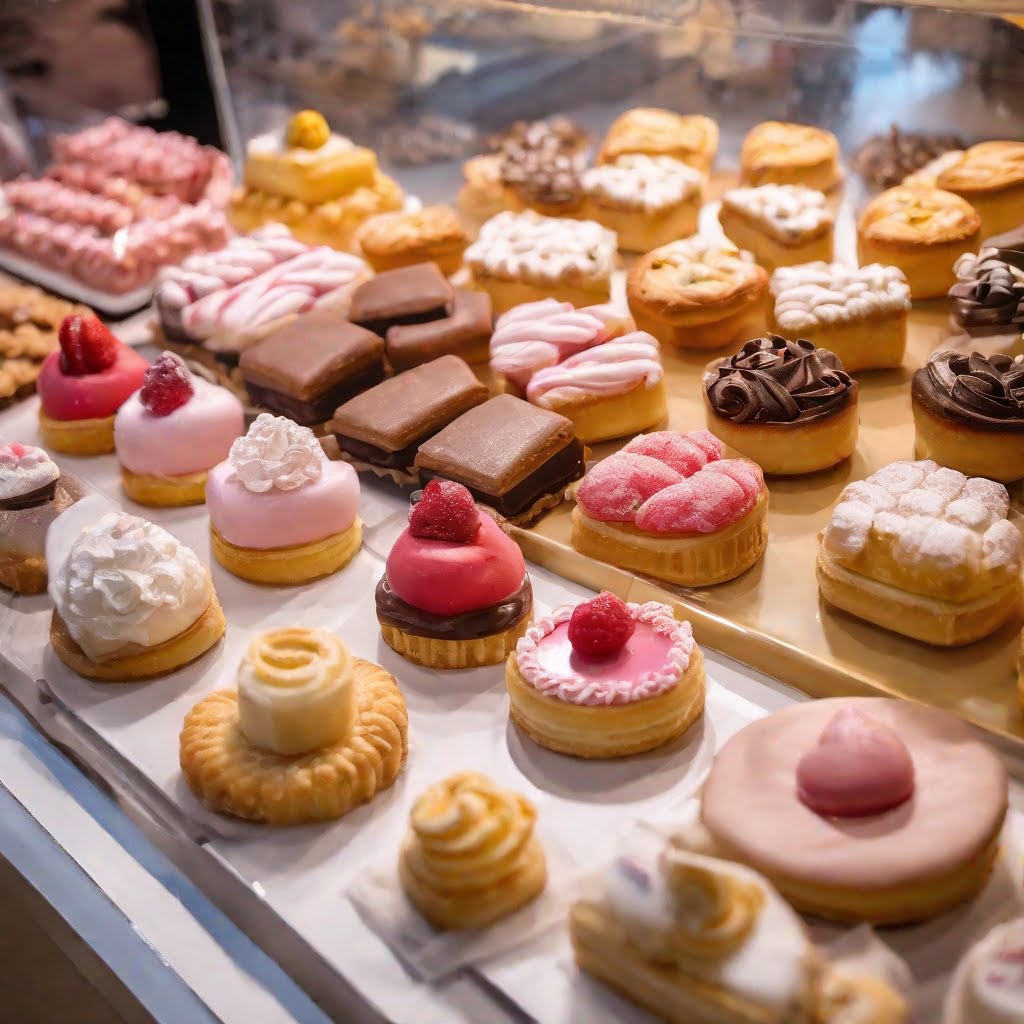
Although non-nutritive sweeteners (NNS) may seem like a solution, there is also growing evidence of NNS being implicated in the development of metabolic abnormalities. However, we should close this can of worms for the time being because it is a separate topic that would require a separate article to discuss. The takeaway here is that sweeteners are not good for you and should be avoided.
In any case, in my opinion, the healthiest way to indulge your sweet tooth is through fruit in moderation or small treats. Pay attention to added sugars where you least expect them! Checking labels will help limit excess sweetness sneaking into your diet.
Sugar and Your Pancreas
The pancreas is an unsung hero, steadily working behind the scenes to keep our blood sugar in check. This humble organ has not one but two very important jobs.
First, the pancreas produces digestive enzymes that act like little pac-men, chomping away at the carbohydrates, fats, and proteins in our food so we can absorb the nutrients. We’d have some serious digestive trouble without those enzymes breaking things down!
But the pancreas’ second role is even more vital – pumping out insulin, the master hormone that unlocks our cells and allows sugar to be used for energy. When we eat foods containing carbohydrates like sugars and starches, they get broken down into glucose and fructose, entering our bloodstream as blood sugar. The pancreas monitors these levels, secreting insulin when blood sugar gets high after a meal. Insulin escorts the sugar into cells throughout the body to be used for fuel.
Like a bus driver picking up passengers, insulin keeps transporting sugar from the blood until levels come back down. This keeps blood sugar in a healthy range. The next illustration depicts the regular functioning of the pancreas concerning the production of insulin and the transportation of glucose from the bloodstream to cells:
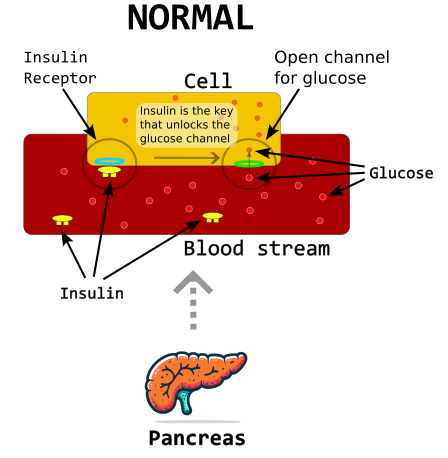
But here’s the catch – the pancreatic beta cells that produce insulin can get “burned out” if we overload them. Just like a bus driver who never gets breaks will eventually suffer exhaustion, the pancreas tires out if it constantly has to produce high amounts of insulin to handle blood sugar spikes.
And what causes these continual sugar spikes? You guessed it – eating too much added sugar and refined carbs. Our poor pancreas wasn’t designed to handle the amounts of high fructose corn syrup and processed foods in modern diets.
Over time, prolonged pancreatic strain can lead to insulin resistance, where the body starts ignoring insulin’s signals. Gradually beta cell function declines until the bus driver has to throw in the towel, leaving sugar stranded in the blood. And this metabolic distress is what underlies type 2 diabetes.
The solution lies in respecting our pancreas, limiting added sugars, and keeping blood sugar spikes occasional rather than constant. With a balanced diet, our pancreatic bus driver can stay rested and energized for the long haul.
The following illustration shows how the glucose absorption by the cell in individuals with both type 1 and type 2 diabetes is blocked, for different reasons:
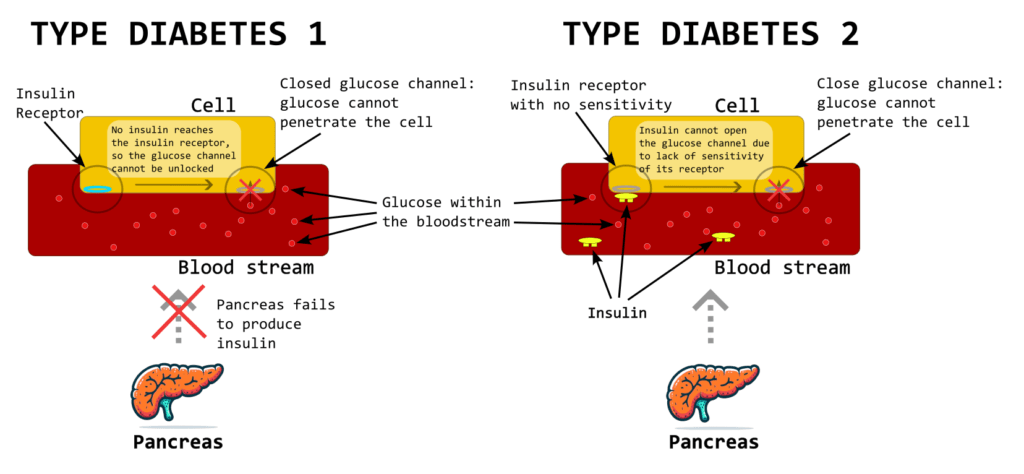
Sugar and Your Liver
The liver is the body’s multitasking powerhouse, juggling hundreds of jobs that keep us alive. But one of its most important roles is regulating blood sugar.
After a meal, glucose from digested carbs enters the bloodstream. The liver helps balance these sugar spikes by pulling glucose out of the blood and storing it as glycogen. It’s like the liver is equipped with a special glucose parking garage!
When blood sugar drops, the liver can release some parked glucose back into the blood as fuel. This prevents crashes and keeps sugar levels steady.
But here’s where fructose – increasingly added to foods as high fructose corn syrup – strains the liver’s sugar-balancing act. While glucose can be dispersed for quick energy or parked in the liver’s glycogen garage, the liver metabolizes fructose differently. It gets converted into fatty acids, which can raise fat production and blood triglyceride.
Plus all these fatty acids may block the glucose parking spots! With its glycogen garages filled with fat, the liver loses glucose regulation capacity. Like a parking lot overflowing with cars, there’s no room left for proper sugar storage and release.
Over time, excessive fructose intake from processed foods and sugary drinks can really overwhelm the liver. And a fructose-flooded liver becomes resistant to insulin’s signals, no longer able to properly regulate blood sugar. This leads to insulin resistance, metabolic dysfunction, and a higher risk of type 2 diabetes. For an in-depth examination of how sugar and fructose overconsumption disrupts metabolism to drive disease, see Dr. Robert Lustig’s insightful lecture here.
- Explanation of gluconeogenesis, a process for glucose production: Physiology, Gluconeogenesis
The solution? Be kind to your hardworking liver by limiting added fructoses, and let it focus on metabolizing glucose and keeping sugar balanced. A healthy liver equals healthy blood sugar!
Gluconeogenesis: The Body’s Backup Glucose Maker
Another interesting fact is that, even without dietary carbs, our bodies can make glucose through a process called gluconeogenesis. This metabolic capability is like having a backup generator for glucose production.
Gluconeogenesis occurs mainly in the liver and kidneys. When carb intake is low, such as during fasting, starvation, or ketogenic diets, this pathway kicks in to synthesize glucose from other substances.
The liver and kidneys produce glucose using lactate, glycerol, amino acids and other glucogenic substrates. This requires energy but prevents hypoglycemia when dietary carbs are lacking.
Gluconeogenesis is regulated by insulin, glucagon and other hormones. It helps maintain normal blood sugar levels even without much carb intake from food.
This glucose backup system means we can tap into stored fat for energy during carb restriction or fasting. Our bodies can run on ketones from fat breakdown while still having minimal glucose from gluconeogenesis to meet the needs of certain organs like the brain.
So through metabolic flexibility, we aren’t totally dependent on dietary carbs for glucose. Our amazing bodies can fuel themselves through fat burning and sugar making when carbs are low!
The following illustration depicts the coordination of the pancreas and liver for blood sugar balance or homeostasis:
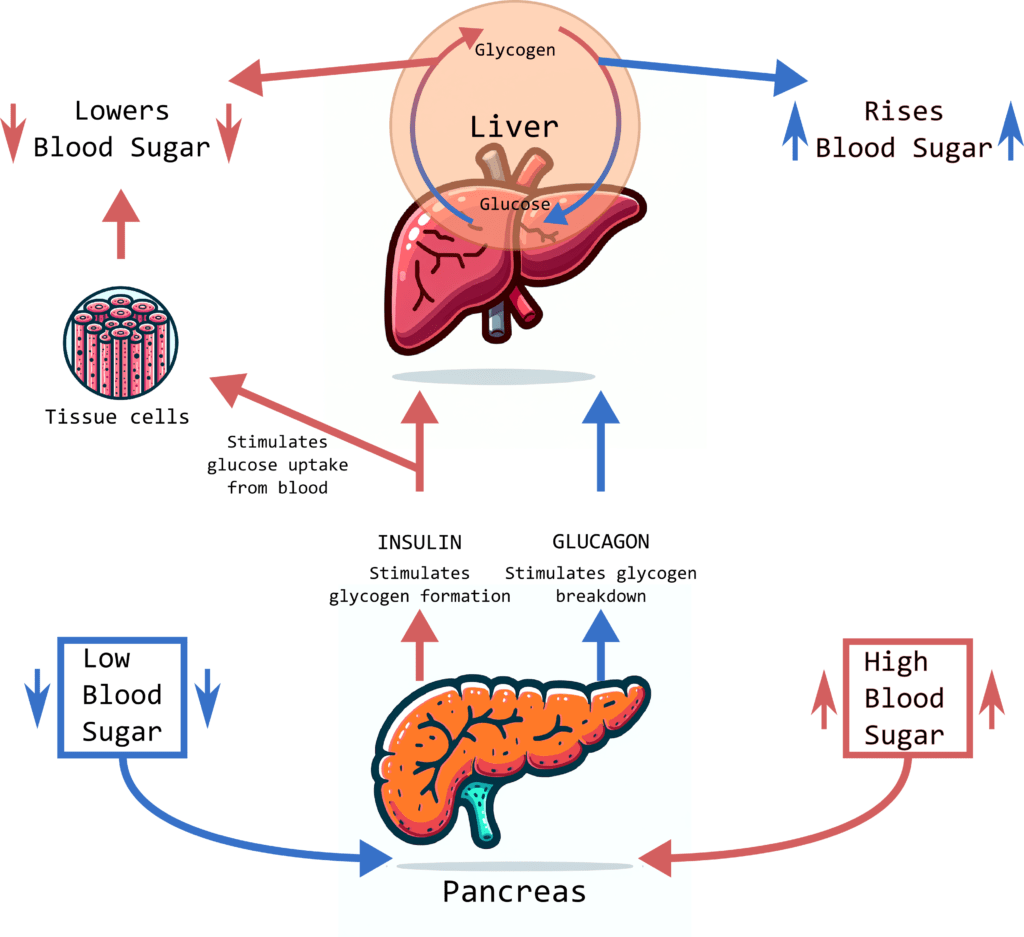
My Sugar Freedom
Quitting sugar was difficult after a lifetime of unconscious addiction, but I’m so glad I finally broke free from its rollercoaster highs and lows. At home, we avoid candies or bakery treats, and if we indulge, we opt for healthier versions made with natural sweeteners and gluten-free flours. Cutting out refined carbs and pasta has been a real turning point – I feel much more balanced and at ease now.
My body is thanking me for the sugar detox too. I have steady, lasting energy without crashes, which is wonderful! Moderation and mindfulness about sneaky sugars is key for me. With some smart strategies, I’m learning to keep sugar in its place and truly savor occasional sweet treats. It feels empowering to finally take control of sugar rather than let it control me!
Your Turn to Share: Have you navigated a similar journey with sugar? We’d love to hear your experiences and thoughts. Don’t hesitate – join the conversation and share your insights with us!

